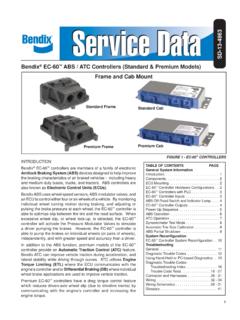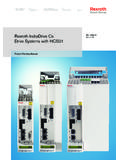Transcription of WaterSense Labeled Weather-Based Irrigation Controllers
1 WaterSense Labeled Weather-Based Irrigation Controllers Technology Description What Are They? Weather-Based Irrigation Controllers (WBICs) are a new generation of smart Irrigation Controllers that use current weather data to properly adapt Irrigation schedules. The Environmental Protection Agen . cy's (EPA's) WaterSense program labels WBICs that have been certified by a third party to meet efficiency and performance criteria detailed in the WaterSense Specification for Weather-Based Irrigation Controllers . WaterSense Labeled Controllers must be able to adequately meet the watering needs of a landscape without overwatering. Weather-Based Irrigation controller How Do They Work? The Weather-Based technologies in WaterSense Labeled Controllers adjust the Irrigation system's station run times based on plants' watering needs rather than on a preset, fixed schedule. A WaterSense Labeled controller automatically reduces the watering times or days when less water is needed, typically during the cooler months.
2 As outdoor temperatures increase or rainfall decreases, Labeled Controllers adjust Irrigation systems' watering run times or schedule to compensate for the fluctuation. They will automatically alter their Irrigation schedules daily or weekly based on site-specific variables, such as soil type, sprinklers' application rate, and local weather changes. WaterSense Labeled Controllers have the poten . tial to save homeowners across the United States 110 billion gallons of water and roughly $410 million per year on utility bills by continually balancing plants' changing requirements with environmental changes. What Product Types Are Available? There are three basic types of WBICs: stand-alone Controllers , add-on devices, and plug-in devices. All three types of WBICs are available in a variety of sizes appropriate for small residential and large commercial applications. Add-on and plug-in devices connect to standard clock timer Controllers and modify their Irrigation schedule.
3 Light commercial products often have the same features as the residential products, but with greater station capacity. Computerized central control systems are typically used for large properties, such as parks, school districts, and golf courses, and are not discussed in this fact sheet. There are two primary technologies employed by WBICs: onsite sensor- based control and signal- based control. Onsite sensor- based Controllers use real-time measurements of locally measured factors ( , temperature, humidity, solar radiation) to adjust weather sensor Irrigation scheduling. An onsite sensor- based system may have historic weather information for the site programmed into memory, which it can use to modify the expected Irrigation requirement for the day or calculate onsite evapotranspira . tion (ET) for the landscape. In contrast, signal- based Controllers receive a regular signal of prevailing weather conditions via radio, telephone, cable, cellular, Web, or pager technology.
4 The signal typically uses data from local weather station(s). to update the current schedule for the controller . July 2012 (866) WTR-SENS (987-7367) One Piece of the Puzzle An Irrigation system is a collection of pipes, fittings, valves, and Concepts Unique to the Technology sprinklers. At the core of an Irrigation system is the controller , Evapotranspiration (ET): WBICs use real- or clock, where electronic signals that turn on and off irriga time weather data to schedule Irrigation tion valves are generated and Irrigation run times and run days based on local ET. ET is defined as the quan . are set. The controller is the key interface between the irriga tity of moisture that is both transpired by tion system and person in charge of operating that system , or the plant ( , the water vapor released from the end user. It controls when and how much water is applied its leaves) and evaporated from the soil and to the landscape.
5 The controller is important, but even the plant surfaces. As demonstrated in the figure best, most water-efficient controller cannot compensate for below, ET is a function of weather conditions poor Irrigation system design, installation, and maintenance. A and plant type. holistic approach to Irrigation systems, landscape design, and Signal Fee: Some controller technologies maintenance is required to achieve the full potential of water require the owner to pay an annual fee to savings. receive a signal that adapts the Irrigation Using the controller schedule to prevailing local conditions. Failure to pay this signaling fee transforms a Installation signal- based smart controller into a conven . Instructions for installing WBICs are available within the prod tional controller . uct packaging and online. Most manufacturers also provide training on the installation and operation of their Irrigation Rainfall Device: This device senses or mea.
6 Controllers for professionals to learn more about installing sures rainfall to reduce or interrupt Irrigation these products. in response to rain events. The technology includes, but is not limited to, rainfall inter . Programming for Water Savings rupt devices and tipping bucket rain gauges. Correctly programming the controller is necessary to achieve water savings. Many Controllers have default settings to water plants at levels sufficient to meet 100 percent of a plant's theo . retical water needs ( , 100 percent ET). These theoretical wa . ter needs have been calculated based on a single crop type in a single microclimate, where the focus was on maximizing yield. Landscape plants, however, should be treated differently than crops because a landscape typically reflects a mixture of plant species with varying vegetation density and microclimates, and most plants will require less than their theoretical water needs to maintain proper health and appearance.
7 Thus, a WBIC can be adjusted to better reflect the plant's water needs. Providing the correct programming inputs on these Controllers using the site-specific parameters is imperative to achieve an appropri . ate watering level. The percent adjust, or water budget, feature present on all WaterSense Labeled Controllers is a simple way to adjust the amount of water that is applied to the landscape. This feature should be a simple dial or button to allow more or less water to be applied to a specific Irrigation zone. Maintaining Savings Once a WaterSense Labeled controller is installed and pro . grammed, the controller automatically takes care of seasonal weather - and site-specific adjustments, thereby not requiring constant monitoring. However, it is important to communi . cate to the end user that no Irrigation control system should be Image Source: installed on the basis of set it and forget it. Users will need to July 2012 (866) WTR-SENS (987-7367) periodically inspect the landscape to ensure that the Irrigation system is performing properly.
8 This is especially important after originally installing the controller . Inform users that they should spend a couple of weeks monitoring their landscape. If everything looks lush and green, they can try dialing down the water budget feature on the controller . Users should continue to adjust the controller 's water budget feature until they find a balance that is both water-efficient and healthy for their plants. Performance WaterSense Labeled Controllers have many capabilities that allow them to be water-efficient, including the following features: WaterSense created criteria to label high- Non-volatile memory ensures that information regarding the performing WBICs. Irrigation program and settings are retained when the power source is lost and no backup battery is available. WaterSense Labeled Controllers are certi . Zone-by-zone control successfully manages landscapes that fied to meet plants'. have multiple areas with various watering requirements that water needs without need to be managed separately.
9 Overwatering. All la Certi ed by beled Controllers have [Certi cation Body]. User notifications alert the user if the controller is not operat . an Irrigation adequacy ing in smart mode ( , if there is a problem with the signal greater than 80 percent in each Irrigation zone or local sensor input that is prohibiting it from automatically and an Irrigation excess less than 5 percent adjusting Irrigation ). averaged across all Irrigation zones. This means The ability to connect to a rainfall device is an important that the controller applies sufficient water to component of an efficient Irrigation system in many climate meet plants' needs (adequacy) without water . regions. Multiple states have mandated the inclusion of ing beyond those needs and thereby generat . these devices by law. ing runoff (excess). The accommodation of watering restrictions addresses users' need to comply with local utility mandates. The percent adjust (water budget) feature allows users to adjust water applied to the landscape without changing the detailed settings in the controller 's program.
10 The ability to rely on a conservative watering schedule if the product loses real-time weather input or a weather signal is accomplished by using a proxy of historical weather data or a percent adjust (water budget) feature. The controller has the capability of automatically returning to smart mode if switched to manual mode. Controllers are often turned to manual mode for troubleshooting or other reasons and not returned to smart mode. This requirement ensures the controller will automatically return to smart mode within a specified time period as designated by the manufacturer. For a list of WaterSense Labeled Controllers , visit the WaterSense website at Communicating the Benefits to Consumers A properly designed, installed, maintained, and operated automatic Irrigation system can provide appropriate application of water across a landscape, as well as convenience to the user. The controller is fundamental to the operation of the Irrigation system, the amount of time each zone operates, and, conse.












